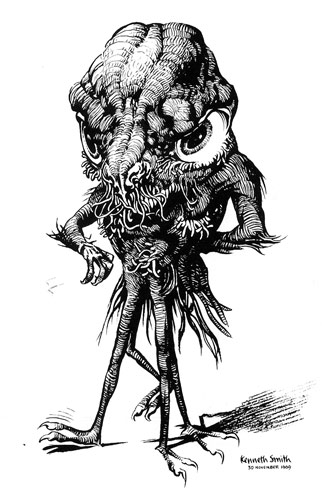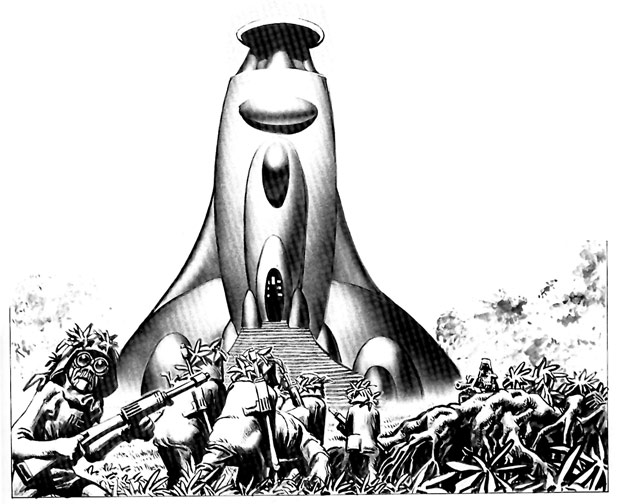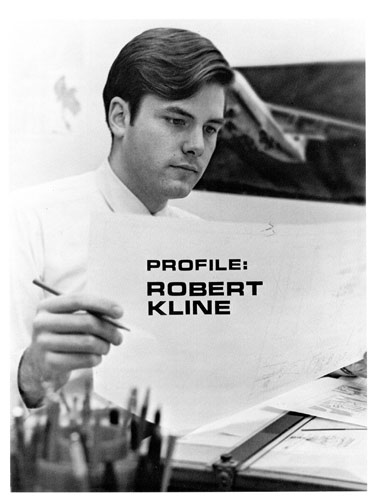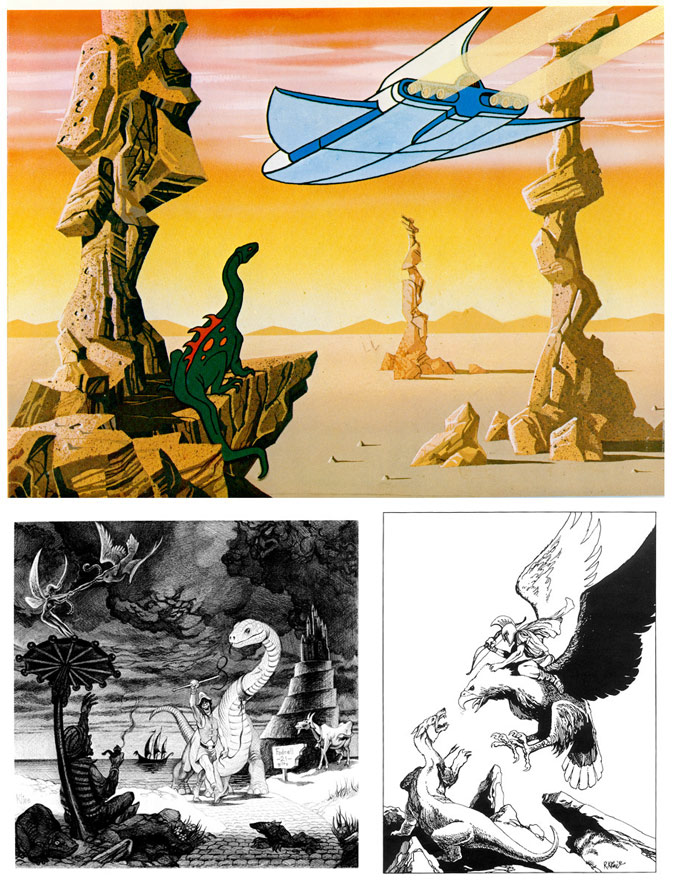Jan Strnad has written for Warren, DC, Dark Horse, the television industry, and published several books. But he cut his teeth on his very own fanzine, Anomaly!
Anomaly 3: 1971
Editor and Publisher: Jan Strnad
 Writer Jan Strnad is probably best known as one of the main, if not THE main collaborator of artist Richard Corben. Jan was the second person (after Voice of Comicdom, by Rudi Franke) to publish Corben’s work, and worked with Corben many times in his career. They collaborated in fanzines, underground comics, and later, mainstream comics. You can see Corben’s cover for this issue of Anomaly below. The partnership remains a substantial part of the writer’s career, but Strnad has done much, much more.
Writer Jan Strnad is probably best known as one of the main, if not THE main collaborator of artist Richard Corben. Jan was the second person (after Voice of Comicdom, by Rudi Franke) to publish Corben’s work, and worked with Corben many times in his career. They collaborated in fanzines, underground comics, and later, mainstream comics. You can see Corben’s cover for this issue of Anomaly below. The partnership remains a substantial part of the writer’s career, but Strnad has done much, much more.
 Anomaly was one of the best fanzines of the time. Packed with great artists such as Corben, Robert Kline, Reed Crandall, Stephen Hickman, Roy Krenkel, as well as writers such as Harlan Ellison and Strnad himself, it inhabited the upper echelon of the fanzine world in the 1970s. For this column, we will examine the final fanzine version, issue 3.
Anomaly was one of the best fanzines of the time. Packed with great artists such as Corben, Robert Kline, Reed Crandall, Stephen Hickman, Roy Krenkel, as well as writers such as Harlan Ellison and Strnad himself, it inhabited the upper echelon of the fanzine world in the 1970s. For this column, we will examine the final fanzine version, issue 3.
Jan Strnad discovered fandom in junior high school through G. B. Love’s Rocket’s Blast Comic Collector (RBCC), with his friend Don Bain, a fellow comic book fan. Strnad would later go on to write for many other fanzines, including RBCC, The Monster Times, George, and Infinity. Strnad adds “I’m sure there are more, but as Hec Ramsey said, a lot of stuff’s gone under the thing since then.”
Strnad knew his calling from the very beginning:
I’ve wanted to be a writer since I was 14 or so. I was thrilled to receive a portable Smith Corona typewriter around that age. I typed up a published science fiction short story (sorry, I don’t remember which one!) just to see what stories looked like in manuscript format. Unfortunately I typed it single-spaced so I only got an approximation, but it helped to cement in my head that stories were words on paper, typed by a mortal human, and thus something I could aspire to create.
Anomaly came about a few years later while Strnad was in college, “pursuing my degree in English Lit. I had no professional credits at all, but I would soon get them through the pages of Creepy and Eerie magazines, published by Jim Warren. Warren paid $45 for an eight-page story at that time, which happened to equal the rent on my ghetto apartment in Wichita.” The first issue of the fanzine was published when Strnad was only 18.
Don and I visited Jerry Weist, a fellow Wichitan who was publishing Squa Tront, and I was inspired to do my own fanzine. Jerry handed me an envelope of sketches by a fan named Robert Kline. He liked the work but it didn’t fit with Squa Tront, so I wrote to Bob and he became a contributor and friend. Later he helped me get a job at Disney when I moved to Los Angeles. My first editor, Jymn Magon, was an Anomaly subscriber, as it turned out.
Richard Corben (see above) would enter Strnad’s world very early as well. The writer recalls his first “almost encounter” with Corben:
Don Bain and I were at the World S-F Convention in St. Louis in 1969 (I think that’s where and when). We had a table where we hawked Anomaly. I was away from the table when Richard came by and subscribed. I discovered his subscription when I got back home and my jaw dropped. I’d seen his work in Rudi Franke’s Voice of Comicdom and couldn’t believe that I’d missed meeting him because I was in the bathroom or somewhere. I approached him about contributing to Anomaly and he kindly accepted my invitation. Don and I later met him in Kansas City and I visited a number of times over the course of our collaborations.
In addition to his writing skills and his good taste in artists, I was also impressed at the actual design of issue three. The editorial pages are spacious and tastefully typeset. When asked if Strnad considered himself talented or experienced in this area, he demurred:
Not really, but I had an interest in printing, publishing and graphic design. I worked for about a week for a printer, learned some prepress, how to basically run an offset press, and hung around City Blue Print (Anomaly‘s printer), enough to make a pest of myself.
I briefly considered a career as an artist but my brain worked better with words. I considered myself a serviceable layout artist and it was something I enjoyed playing with. For instance, with Anomaly #3 I had the money for a couple of pages of color and the normal thing to do would be to put it on the covers. But since I didn’t have any newsstand distribution, where a color cover would help sales, I thought it would be fun to put the color on the inside, unsullied by type, and let the reader happen upon it unexpectedly.
The experience with Anomaly helped immensely when I published Mad Dog Graphics and did all my own layout work.
The color piece Strnad references is an animation cell style color painting from Robert Kline, who is featured in an interview, accompanied by many spot illustrations, a couple of full-page drawings, and the aforementioned color piece. The interview itself benefits greatly from Strnad’s skills as a writer. It is not a simple question and answer piece, as you would see in several other fanzines (though Gary Groth’s Fantastic Fanzine gets a warm plug). Quotes are interspersed intelligently and many subjects are covered, including a visit by the editor and a friend to Disneyland while Kline was finishing classes at Art Center, on his way to working for Disney as an animator.
Various assignments at Art Center are discussed, informing Kline’s work and our understanding of him and his experiences. Other topics are covered as well, such as Kline’s admiration for Frank Frazetta, and stop-motion pioneer Ray Harryhausen.
Following Kline’s interview is a Roy Krenkel portfolio, consisting of six beautiful full-page illustrations (some pencil, some fully inked). Though Krenkel had the misfortune of working in the paperback market in the same era of his friend Frank Frazetta, his work truly deserves attention. The work is intelligent, detailed, and incredibly imaginative, as seen below.
Herb Arnold (below) follows with a portfolio of his own. I always saw Arnold as a poor man’s Corben, probably due to the fact that they seemed to appear in many of the same places, doing similarly toned work. Though very few can hold a candle to Corben, seen separately, Arnold’s work is worthy. The illustrations are moody and atmospheric, especially when the work stays in the realm of horror, the artist’s genre of choice. A feature in the first few pages of the fanzine, “The Castle of the King,” written by Strnad, showcases Arnold’s use of deep blacks, varied pen work, and selective use of duo-shade and zip-a-tone (relics in today’s digital world, but effective nonetheless). Unfortunately, the first feature also shows figures that are at times stiff, with a few specific elements (such as hands) that don’t quite work. Strnad states that, “I met Herb through Richard Corben. He was, at that time, another Kansas Citian, and he was a big Lovecraft fan.”
Kenneth Smith (who also did the logo you see at the top of the page, along with several spot illos and other logos) contributes a story called “The Bog,” which is much lighter and less obsessively detailed than his usual work. I say that with much love and respect for his obsessively detailed work, by the way! At some point, I hope to at least show some snippets of his incredibly beautiful fanzine, Phantasmagoria (there is a full page ad for the zine which shows what amazing work Smith could produce).
Smith’s good humor shows brightly in this whimsical short story, both in the writing and the design of the main characters. At a few points (as seen above) we do see flashes of the incredible control Smith had over his brush. Heck, his lettering was even top notch!
The next and last story (see above) is probably what this fanzine is best known for, Strnad and Corben’s alien abduction/war parable, titled “Encounter of War.” Corben’s deft handling of action is evident even in this early work, as is his command of realistic shadow play.
An editorial rounds out the text this issue, in which Strnad ruminates on the future of the fanzine. Strnad ponders whether it can continue as it is, losing money, or try a run as an underground…which it actually did for one issue. Strnad elaborates, saying “three issues were in fanzine form, and then Bud Plant printed Anomaly #4 as an underground comic book. I published the fanzine until my money ran out, like the joke: ‘How do you make a small fortune in publishing? Start with a large fortune.’ Only I started with $1000 and when it was gone, it was gone! It was always a hobby, not a career, and once I began to write professionally, I didn’t really need it as a creative outlet.”
Strnad’s writing career has prospered since his fanzine days. Jan breaks it down, category by category:
In comics, the highlights of my so-called career are definitely working with Gil Kane on Sword of the Atom for DC and working with Dennis Fujitake on Dalgoda for Fantagraphics. Dalgoda also contained my first collaboration with Kevin Nowlan, Grimwood’s Daughter, which has been collected into a graphic novel by IDW.
I worked with Kevin again on “The Secret Origin of Man-Bat” and, in volume one of Batman Black & White, Monsters in the Closet, which also carried the Corben-illustrated story “Monster Maker.” Incidentally, those two “monster” stories were conceived as a unit where Kevin would illustrate the comic book art in Corben’s story and vice versa, and one story would lead into the other and back again. Kevin didn’t want to sully his pages with someone else’s art, though, so that idea fell through. If you cut those pages out of the book and tape them together in a Moebius strip, you’ll still get the effect.
The Corben collaborations included various underground comix and my favorites, Mutant World and The Last Voyage of Sindbad (aka New Tales of the Arabian Nights when serialized in Heavy Metal magazine). We parodied Den in “Denz“ for Penthouse Comics, which I thought was a better story than it needed to be.
In animation, I wrote a couple of Talespin episodes for Disney before going on staff, where my first job was the Darkwing Duck pilot episode, which came real close to being a direct-to-DVD film. I went on to write for Goof Troop, Aladdin, Hercules, 101 Dalmatians and other Disney shows before being fired. Then I freelanced for various studios and wrote some Spider-Man (Kraven the Hunter), Fantastic Four, Iron Man and X-Men cartoons, and smaller studio stuff including Ace Ventura, Pet Detective; Skeleton Warriors; Harold and the Purple Crayon (which I loved as a very young child) and others. My favorite animation gig was writing and editing Project: GeeKeR for Sony/Columbia/CBS which TV Guide called the best new cartoon show of the season. Unfortunately it ran opposite Spider-Man and got creamed in the ratings.
“Encounter at War” in Anomaly 3 also ran in Marvel’s Epic Illustrated.
My first and only movie job was on Judge Dredd, for which I wrote a treatment. Absolutely none of what I wrote was used in the film and I didn’t get a “credit,” thank goodness. Mutant World was optioned for an animated film by Phil Tippett and Jon Davison, but it went nowhere, and my horror novel, Risen, has been optioned five times, several times by Ralph Singleton (who made three Stephen King movies), but again, no film has resulted.
In live action TV I wrote one episode of Young Hercules but was fired by Rob Tappert before he even read the script, a casualty of a mass firing of writers. I don’t think much of Rob, but his wife (Lucy Lawless) is very sweet.
I’m making a student film with real high school students, called Things Change, just for fun, but it’s like pushing a rope. We lost a whole day of shooting for which we had our full cast of characters, extras, crew, etc. all lined up when our lead actress got grounded. “Making films is hard,” as Barbie might say.
Jan is pretty active on Facebook, so go say hello!
Please download the pdf, so you can see all the wonderful work in this gorgeous fanzine! My thanks go out to Jan himself, who availed much of his time via email for all my questions! Ink Stains is monthly for the time being, by the way, on the first of every month. Next installment…don’t know yet!
Ken Meyer Jr.
kenmeyerjr@yahoo.com










Great work Ken. Strnad’s writing is the best of the Undergrounds. Too bad about Project Geeker. That was one of Doug T’s earlier brushes with success.
I owned these by the way. Seeing these pages brings it all back. I remember being way over impressed by Kenneth Smith. The guy could render the hell out of things but needed a few more drawing lessons before he devoted that much time to finishes.
Pingback: Tweets that mention Ink Stains 21: Anomaly 3 -- Topsy.com
Fantastic! What great artwork in that book (especially that first pic with the astronauts). Great to see you back KMjr!
Another fascinating read. I’m lucky enough to have Anomaly #4, but the fanzine versions have always intrigued me.
Thanks for the comments, guys (Ellis liked it so much, he commented twice)! Good to be back and I have some good ones lined up, such as Phase 1, Reality, some smaller zines, and more!
Paul, I don’t know if you would be willing to lend me that copy of Anomaly to scan for a future column…but, email me if you are!
Thanks, Ken, for the link here once again (in my case, from your journal at deviantART). Even when I don’t read every word of the descriptions and artistic byplay, the art from these fanzines is invariably fascinating and often world-class in quality.
What, Greybird? You don’t hang on my every word??? I am hereby revoking your membership in my fanclub! Turn in your Dr. Pepper badge this instant!
Thank you so much for all of the great work that you do, Ken. As a fanzine lover from way, way back, I find your contributions to Comic Attack invaluable and I eagerly await new additions.
Vince, thanks a ton. It’s really nice to know people are actually reading. I know the ratio of actual comments to actual readers is off the charts, but it is still really nice to actually hear from people and not think the columns are just going off into a void. I may be able to go back to a twice monthly schedule soon, we’ll see.
Hi Jan! Not only did I have Anomaly, I also bought the two Robert E. Howard posters that you & Kline put out in the 70’s! Hope yer doing well!
Jymn
Pingback: Ink Stains 34: Anomaly 1